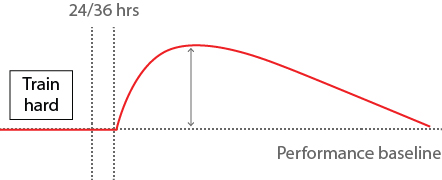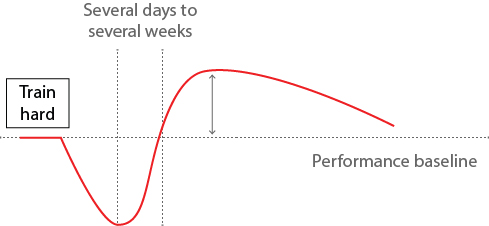
Overtraining
Training is all about putting sufficient stress on the body during workouts to reach a point where your body supercompensates after, building strength back up to, and above, your pre-workout level. As this process is repeated the body increases its resistance to workout stress and builds strength. This is known as functional overreaching (FOR); purposefully overloading and recovering sufficiently to benefit from the body’s supercompensation.
Stress and overreaching
If you do not recover sufficiently before working out again the cumulative stress put on your body will increase to the point you can no longer supercompensate. This quickly becomes Non Functional Overreaching (NFOR), as you are not getting stronger or improving, as such the overloading is not achieving your goal of increased strength. NFOR is also known as under recovery as it is just that, insufficient periods for your body to recover between workouts.
The different stages of training-induced fatigue
1. Acute fatigue
- High perceived fatigue
- No performance decrement after a 24/36 hour rest period
- Performance supercompensation

2. Functional overreaching
- Very high perceived fatigue
- Short-term performance decrement
- Performance restoration takes from several days to several weeks
- Performance supercompensation

3. Non functional overreaching
- Very intense perceived fatigue
- Short-term decrement in performance capacity (
- Performance restoration…without supercompensation

4. The overtraining syndrome
- Very intense perceived fatigue
- Long-term performance decrement (>1 month)

When considering cumulative stress it is important to remember that physical stresses from workouts are not the only factor. Mental and chemical stress can also play a huge role in under recovery/overtraining.
Autonomic Nervous System (ANS)
The autonomic nervous system controls the involuntary functions of the body, such as heart rate, blood pressure, digestion, and the production of hormones. It is comprised of two branches – the sympathetic (fight or flight) branch which prepares the body for action, and the parasympathetic branch, that controls rest, digestion and recovery. Although sometimes termed the “accelerator and brake” the two branches really work together dynamically in a harmonious continuum to adjust the body’s unconscious activities to just the right level all the time.
What happens to the ANS during overtraining and why?
When the body registers stress (physical, mental, chemical or cumulative) the sympathetic branch of the ANS is stimulated and increases its activity significantly. The body effectively prepares for fight or flight, releasing adrenaline and cortisol, instructing the liver to release glucose and suppressing activity of the parasympathetic branch.
In the short term (a matter of hours) this is not a problem, the body can cope. But a key problem in modern life is the chronic activation of the sympathetic branch, due to all the many sources of stress, including training, work, relationships and what we put into our bodies. Overtraining causes the ANS to behave this way for extended periods of time which the body cannot sustain without consequence.
Everyone needs periods of rest and recovery when the parasympathetic branch is dominant, but the amount depends very much on the individual.
Heart rate variability (HRV) monitoring is a great way to observe when stress is becoming chronic.
Heart rate variability (HRV) is a great barometer of overall health
Whilst many people know the heart beats a certain number of times per minute most do not know that these beats are irregular. The heart speeds up when you inhale, and slows down when you exhale. The difference is known as heart-rate variability and is a great indication of your current level of cumulative stress as it is regulated by ANS activity.
The more variance in the gap between beats the healthier your heart. This is because heart rate variability (HRV) is in fact counter intuitive; a healthy heart has a high variance and can respond to bodily demand more quickly than a tired stressed out organ.
As cumulative stress builds up the heart beat rhythm becomes more regular. HRV has been shown to detect stress and overtraining long before any of the symptoms above are present. If your heart beat variability decreases you may need to consider taking it easy.
